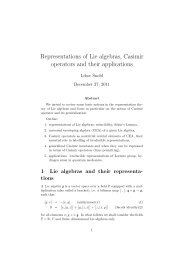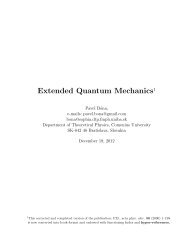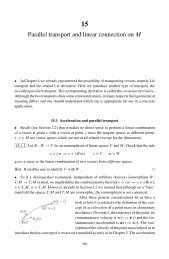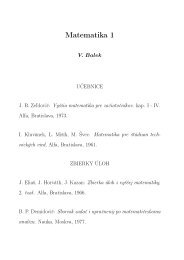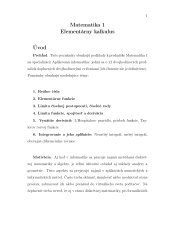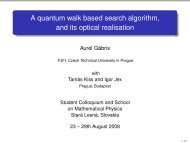Quantum Field Theory I
Quantum Field Theory I
Quantum Field Theory I
You also want an ePaper? Increase the reach of your titles
YUMPU automatically turns print PDFs into web optimized ePapers that Google loves.
60 CHAPTER 2. FREE SCALAR QUANTUM FIELD<br />
The ”miracle”is not overyet. The free field haveturned out to be equivalent<br />
to the system of independent oscillators, and this system will now turn out to<br />
be equivalent to still another system, namely to the system of free non-teracting<br />
relativistic particles. Indeed, the free Hamiltonian written in terms of a ⃗p (t) and<br />
a + ⃗p (t) becomes14 ∫<br />
H =<br />
∫<br />
=<br />
( 1<br />
d 3 x<br />
2 π2 + 1 2 |∇ϕ|2 + 1 )<br />
2 m2 ϕ 2<br />
d 3 (<br />
p<br />
(2π) 3 ω ⃗p a + ⃗p (t)a ⃗p(t)+ 1 ] [a )<br />
⃗p (t),a + ⃗p<br />
2<br />
(t)<br />
wherethelasttermisaninfiniteconstant(since[a ⃗p (t),a + ⃗p (t)] = (2π)3 δ 3 (⃗p−⃗p)).<br />
This is ourfirst example of the famous (infinite) QFT skeletonsin the cupboard.<br />
This one is relatively easy to get rid of (to hide it away) simply by subtracting<br />
the appropriate constant from the overall energy, which sounds as a legal step.<br />
Another way leading to the same result is to realize that the canonical quantization<br />
does not fix the ordering in products of operators. One can obtain<br />
different orderings at the quantum level (where the ordering does matter) starting<br />
from the different orderings at clasical level (where it does not). One may<br />
therefore choose any of the equivalent orderings at the classical level to get the<br />
desired ordering at the quantum level. Then one can postulate that the correct<br />
ordering is the one leading to the decent Hamiltonian. Anyway, the standard<br />
form of the free scalar field Hamiltonian in terms of creation and annihilation<br />
operators is<br />
∫<br />
d 3 p<br />
H =<br />
(2π) 3 ω ⃗p a + ⃗p (t)a ⃗p(t)<br />
This looks pretty familiar. Was it not for the explicit time dependence of the<br />
creation and annihilation operators, this would be the Hamiltonian of the ideal<br />
gas of free relativistic particles (relativistic because of the relativistic energy<br />
ω ⃗p = √ ⃗p 2 +m 2 ). The explicit time dependence of the operators, however, is<br />
not an issue — the hamiltonian is in fact time-independent, as we shall see<br />
shortly (the point is that the time dependence of the creation and annihilation<br />
operators turns out to be a + ⃗p (t) = a+ ⃗p eiω ⃗pt and a ⃗p (t) = a ⃗p e −iω ⃗pt respectively).<br />
Still, it is not the proper Hamiltonian yet, since it has nothing to act on.<br />
But once we hand over an appropriate Hilbert space, it will indeed become the<br />
old friend.<br />
14 The result is based on the following algebraic manipulations<br />
∫ d 3 x π 2 = − ∫ √<br />
d 3 xd 3 pd 3 p ′ ω⃗p ω )( )<br />
⃗p ′<br />
(a<br />
(2π) 6 2 ⃗p (t)−a + −⃗p (t) a ⃗p ′ (t)−a + −⃗p ′ (t) e i(⃗p+⃗p′ ).⃗x<br />
= − ∫ √<br />
d 3 pd 3 p ′ ω⃗p ω )( )<br />
⃗p ′<br />
(a<br />
(2π) 3 2 ⃗p (t)−a + −⃗p (t) a ⃗p ′ (t)−a + −⃗p ′ (t) δ 3 (⃗p+⃗p ′ )<br />
= − ∫ )<br />
d 3 p ω ⃗p<br />
(a<br />
(2π) 3 2 ⃗p (t)−a<br />
)(a + −⃗p (t) −⃗p (t)−a + ⃗p (t)<br />
∫<br />
d 3 x |∇ϕ| 2 +m 2 ϕ 2 = ∫ d 3 xd 3 pd 3 p ′ −⃗p.⃗p ′ +m 2<br />
(2π) 6 2 √ ω ⃗p ω ⃗p ′<br />
= ∫ d 3 p ω ⃗p<br />
(2π) 3 2<br />
)( )<br />
(a ⃗p (t)+a + −⃗p (t) a ⃗p ′ (t)+a + −⃗p ′ (t) e i(⃗p+⃗p′ ).⃗x<br />
(a ⃗p (t)+a + −⃗p (t) )(a −⃗p (t)+a + ⃗p (t) )<br />
where in the last line we have used (⃗p 2 +m 2 )/ω ⃗p = ω ⃗p .<br />
Putting everything together, one obtains the result.




